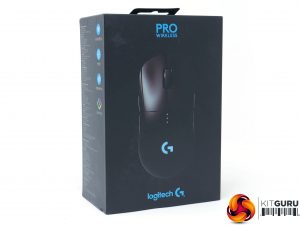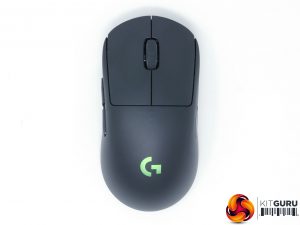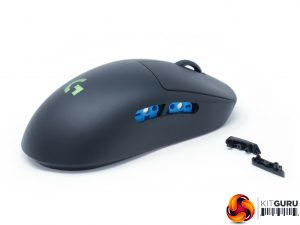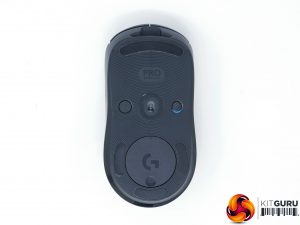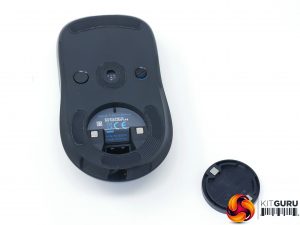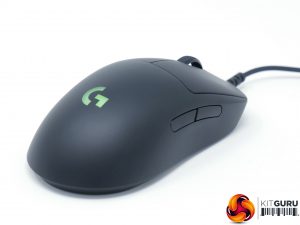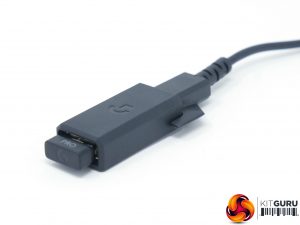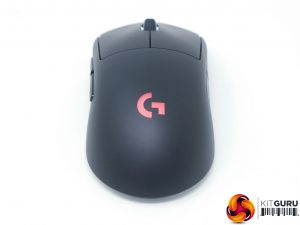In regard to Logitech's cheaper mice, such as the G502 Hero and G Pro wired, every expense is spared when it comes to packaging. They’re cheap, throwaway boxes. With the G Pro Wireless, though, Logitech has stepped things up a bit, in accordance with this mouse’s high price.
You get a nice thick cardboard box that slides open to reveal the mouse that’s held securely held in place by moulded plastic. Remove this and you’ve two little boxes, one of which contains the cable and documentation and the other houses the wireless adapter and replacement buttons.
These buttons are the first standout feature of this mouse. The ambidextrous design has back and forward buttons on both sides of the mouse, but you can actually remove the buttons from the side you don’t use and replace them with blanks. This eliminates the risk of accidentally pressing them. The buttons are held in place by magnets and it’s easy to pop them off.
This seems like it has the potential to make for wobbly, insecure buttons but we encountered no such problems. Both the buttons and blanks are rock solid while the action of the buttons is as good as any other mouse.
In terms of other buttons, you get very few. Along with the four removable side buttons you get just the standard left, right and scroll wheel click. There is also a DPI switching button but it’s on the underside of the mouse. Logitech’s logic is that pro-gamers don’t actually switch DPI mid-game and would prefer to minimise the chances of accidentally hitting such a button in the heat of battle.
Largely we’d agree, though it does seem a fairly bold move – plenty of people do change DPI between games and on the desktop and having quite such an inconvenient solution may put some buyers off.
Also on the underside of the mouse we find a small compartment for storing the wireless adapter. This allows you to use the G Pro Wireless on the move, though if you do fear running out of battery you’ll still have to bring the cable anyway.
The base of the mouse is also home to the on/off switch and four PTFE mouse feet. Their modest size and simple shape doesn’t exactly scream quality but on a mouse this light they should be ample.
As for the adapter itself, it’s a standard USB-A size so Logitech includes a converter that allows you to plug it into the supplied microUSB cable. Said cable has a proprietary plastic shape around the microUSB plug to help minimise strain on the joint, but there is also enough room around the socket on the mouse that you could use an alternative cable.
As for the overall design of the mouse, Logitech has gone for a less is more approach both in terms of the number of features and the size and weight of this mouse. It measures just 125 x 63.5 x 40mm and doesn’t have the pronounced central bulge of many right-hand only mice.
As such, if you’re someone that likes a mouse to fill the palm of your hand, this won’t be the one for you. For fingertip and claw grip users, though, it should suit the majority of buyers.
Meanwhile, a weight of just 80g is exceptionally low for a wireless mouse. Plenty of wired mice that don’t have to account for the weight of a battery weigh considerably more, while most wireless models are well over 100g.
So far so good but the one area where this mouse really doesn’t land is design. The simple symmetrical look is all well and good but there’s no flare here. In fact, the whole thing looks positively cheap. Just something as simple as adding RGB lighting to the scroll wheel like on the SteelSeries Rival 600 or adding rubber to the sides – which would also aid grip – and outlining the transition with a slightly different colour plastic would make all the difference.
Considering the price of this mouse, a little more attention in this area would’ve been nice. We appreciate Logitech has aimed to make as light a mouse as possible but one could then argue that even the RGB Logitech logo shouldn’t be there if weight reduction was the sole aim of the design.
 KitGuru KitGuru.net – Tech News | Hardware News | Hardware Reviews | IOS | Mobile | Gaming | Graphics Cards
KitGuru KitGuru.net – Tech News | Hardware News | Hardware Reviews | IOS | Mobile | Gaming | Graphics Cards


